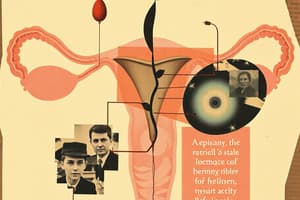Podcast
Questions and Answers
What is the correct sequence of the phases in the ovarian cycle?
What is the correct sequence of the phases in the ovarian cycle?
- Luteal phase, ovulation phase, follicular phase
- Follicular phase, ovulation phase, luteal phase (correct)
- Luteal phase, follicular phase, ovulation phase
- Ovulation phase, luteal phase, follicular phase
What is the primary function of the zona pellucida surrounding the oocyte in the growing follicles?
What is the primary function of the zona pellucida surrounding the oocyte in the growing follicles?
- To allow for the exchange of nutrients between the granulosa cells and the oocyte (correct)
- To facilitate the process of fertilization
- To provide structural support for the oocyte
- To prevent the oocyte from undergoing atresia
What is the primary function of the theca cells in the growing follicles?
What is the primary function of the theca cells in the growing follicles?
- To secrete hormones that stimulate the growth of the granulosa cells (correct)
- To phagocytize the oocyte during atresia
- To facilitate the passage of the oocyte during ovulation
- To provide structural support for the follicle
What is the primary reason for the atresia of many primary follicles that occurs before puberty?
What is the primary reason for the atresia of many primary follicles that occurs before puberty?
Which of the following is the most accurate description of the primordial (primary) follicle?
Which of the following is the most accurate description of the primordial (primary) follicle?
What is responsible for the formation of a Graffian follicle (GF)?
What is responsible for the formation of a Graffian follicle (GF)?
What surrounds a mature Graafian follicle?
What surrounds a mature Graafian follicle?
What is the function of LH surge in ovulation?
What is the function of LH surge in ovulation?
What are the cells that surround the ovum when it leaves the follicle during ovulation?
What are the cells that surround the ovum when it leaves the follicle during ovulation?
What process involves the formation of a functional secondary oocyte?
What process involves the formation of a functional secondary oocyte?
Flashcards are hidden until you start studying
Study Notes
Ovarian Cycle
- The ovarian cycle refers to the changes occurring in the ovary from the initial development of the ovum to the involution of the corpus luteum and the beginning of a new estrous cycle.
Phases of Ovarian Cycle
- The ovarian cycle consists of three phases: follicular, ovulation, and luteal.
Follicular Phase
- The follicular phase consists of primordial, growing, and Graafian follicles.
- Primordial follicles contain a single oocyte surrounded by a single layer of granulosa cells.
- Growing follicles have two or more layers of granulosa cells, a zona pellucida, and two layers of theca cells.
- Atresia of primary follicles occurs by birth and throughout the reproductive life of the female.
- Growth of primary follicles before puberty is not hormone-related and is controlled by unknown intraovarian factors.
Graafian Follicle (GF)
- GF formation is hormone-dependent and begins at puberty with the rise of LH and FSH levels.
- Estrogen released from follicular cells stimulates LH release, which acts with FSH to cause proliferation of the follicular theca cells.
- A mature GF is about 10-20 mm in diameter, surrounded by theca externa, theca interna, and contains follicular fluid or antra fluid with estrogen.
- The GF is lined with a layer of cells called zona granulosa and contains a mature ovum surrounded by granulosa cells (cumulus oophorous).
Oogenesis
- Oogenesis is the process by which oocytes are formed.
- The oogenium or primitive ovum has a diploid number of chromosomes and divides to form primary oocyte, secondary oocyte, and polar bodies.
- The secondary oocyte divides to form an ovum and a second polar body.
Ovulation
- Ovulation occurs due to the LH surge in all species.
- The growing Graafian follicles pass through rapid maturation, increasing in size and moving towards the surface of the ovary.
- The outer layer of the follicle ruptures, releasing the follicular fluid and the ovum, surrounded by cumulus cells (corona radiate cells).
Studying That Suits You
Use AI to generate personalized quizzes and flashcards to suit your learning preferences.




